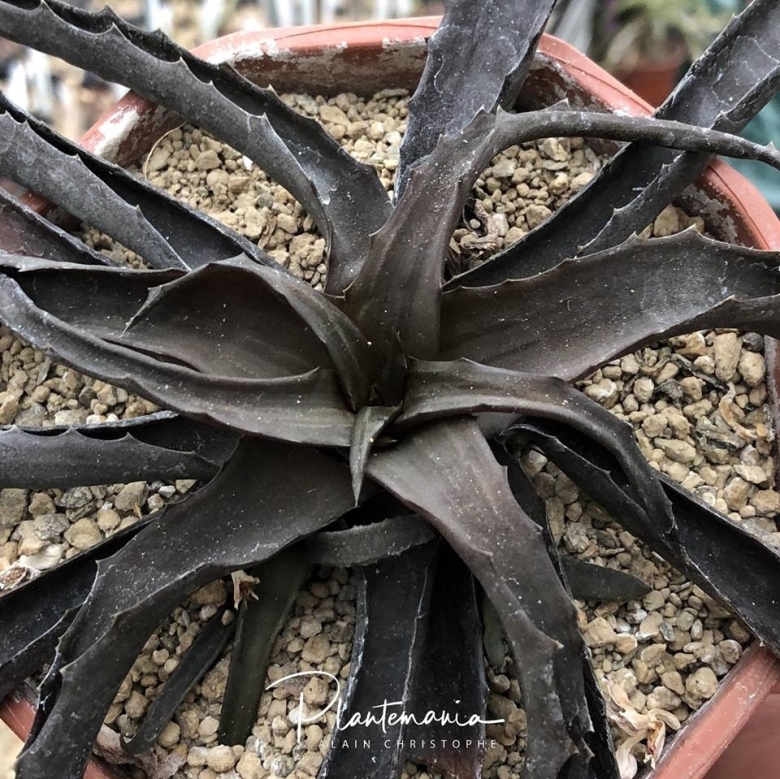




Your support is critical to our success.

Origin and Habitat: Southern Madagascar
Habitat and ecology: Aloe prostrataSN|35521]]SN|35521]] grows in forest on limestone reefs. It might be very rare, extinct in the wild or access to the populations is very difficult.
Synonyms:
- Aloe prostrata (H.Perrier) L.E.Newton & G.D.Rowley
- Lomatophyllum prostratum H.Perrier
Description: Aloe prostrataSN|35521]]SN|35521]], also known as Lomatophyllum prostratumSN|35522]]SN|35522]] is a low growing, stemless, solitary or, stoloniferous species forming small tufts. It has dark, contorted leaves, making it looking like a vegetable octopus prowling on the ground. In habitat it can be often observed that individuals L. prostratum either growing in shade or fully exposed to the sun, not only show morphologically different phenotypes but are also strikingly different in pigmentation, with the shade plants exhibiting a deep green and the sun plants often show intense dark brown or blackish colouration. They bear few-flowered racemes of carmine-red flowers in early summer followed by long-lasting, fleshy, yellowish, berry-like fruits.
Derivation of specific name: The epithet “prostrata/prostratum” comes from the spreading leaves, from Latin ‘prostratus’ (prostrate, creeping).
Leaves: 10-20(-25), densely rosulate, spreading, lanceolate-narrowed, falcate, tip with 3-4 teeth, 15-20 cm long, 1.5-2 cm wide, dark green to dark brown, with many confluent white to greenish spots patches and lines. Marginal teeth 3 mm long, white, 5-15 mm apart. The leaf juice is yellow.
Inflorescence: Racemose, unbranched, up to 12(-17) cm long, simple. Racemes cylindrical, 4-6 cm long, with few flowers. Occasionally, one to two bulbils are formed. Bracts longer than pedicels (5-11 mm long). Pedicels (3-)4-5(-10) mm long.
*Flowers: Bright carmine-red, green tipped, 20-25 mm long, base truncate, 6-7(-9) mm in diameter across the ovary, narrowed to 5 mm above, then extended to the mouth to 6-7 mm. Their outer tepals are not fused together over a length of 5 to 8 mm. The stamens and the stylus hardly protrude from the flower.
Fruits (berries): Long-lasting, fleshy, yellowish.
Notes: The name Lomatophyllum means “fringed leaf”, but it is the fleshy fruits that are characteristic of this genus, which is closely allied to, and most often included in, Aloe.
Bibliography: Major references and further lectures
1) Urs Eggli “Illustrated Handbook of Succulent Plants: Monocotyledons” Springer Science & Business Media, 6 December 2012
2) S. Porembski, W. Barthlott, “Inselbergs: Biotic Diversity of Isolated Rock Outcrops in Tropical and Temperate Regions”, Springer Science & Business Media, 6 December 2012
3) International Succulent Introductions of the Huntington Botanical Gardens, “ISI 2002-31. Lomatophyllum prostratum Perrier” Published in the Cactus and Succulent Journal, Vol. 74 (2), March - April, 2002. web: https://www.huntington.org/BotanicalDiv/ISI/ISI2002/2002-31.html
4) Solofo E. Rakotoarisoa, Ronell R. Klopper, Gideon F. Smith “A preliminary assessment of the conservation status of the genus Aloe L. In Madagascar” Bradleya 32/2014, pages 81–91
5) Olwen M. Grace, Ronell R. Klopper, Estrela Figueiredo & Gideon F. Smith, “The aloe names book”, Strelitzia 28, Pretoria 2011, South African national biodiversity institute SANBI
6) Urs Eggli, Leonard E. Newton, “Etymological Dictionary of Succulent Plant Names.” Springer, Berlin/Heidelberg 2010
7) H. Perrier: “Les Lomatophyllum et les Aloë de Madagascar”. In: Mémoires de la Société Linnéenne de Normandie. Botanique. 1(1): 9, 1926
8) Gordon D. Rowley: “The berries Aloes: Aloe section Lomatophyllum”. In: Excelsa. 17: 61, 1996
9) Werner Rauh, Marc Teissier: “Aloe zombitsiensis Rauh & Teissier spec. nov. (Aloaceae)”. In: Kakteen und andere Sukkulenten. 51(8): 201–203, 2000
10) Werner Rauh, Ralph D. Mangelsdorff: “Aloe ankaranensis Rauh & Mangelsdorff spec. nov. (Aloaceae)”. In: Kakteen und andere Sukkulenten. 51(10): 273–275, 2000
11) Susan Carter, John J. Lavranos, Leonard E. Newton, Colin C. Walker: “Aloes. The definitive guide”. Kew Publishing, Royal Botanic Gardens, Kew 2011, page 233.
| Your Actions | |
|---|---|
| Back to Aloe index | |
| Back to Aloaceae index | |
 |
Back to Succulents Encyclopedia index |
Privacy stantement - Terms and conditions - How to cite - About us - Feedback - Donate



